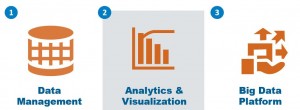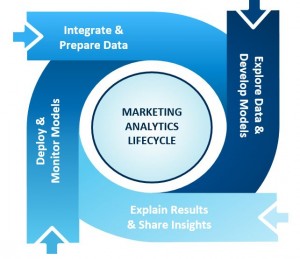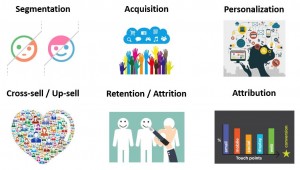I begin this blog post with one goal in mind. I want to raise awareness on the subject of customer and marketing analytics, and why this field is exploding in interest and popularity. Let's begin with a primer for the uninitiated, and lay down some definitions:
Customer Analytics: The processes, technologies, and enablement that give brands the customer insight necessary to provide offers that are anticipated, relevant and timely.
Marketing Analytics: The processes and technologies that enable brands to assess the success of their marketing initiatives by evaluating performance using important business metrics, such as ROI, channel attribution, and overall marketing effectiveness.
If you aren't a fan of textbook definitions, here is a creative alternative:
Still not on board? Here's my perspective on the subject:
Customers are more empowered and connected than ever before, with access to information anywhere, any time – where to shop, what to buy and how much to pay. Brands realize it is increasingly important to predict how customers will behave to respond accordingly. Simply put, the deeper your understanding of customer buying habits and lifestyle preferences, the more accurate your predictions of future buying behaviors will be.
Marketers need to be enabled to benefit from approachable and actionable advanced analytics to make more powerful decisions within today’s complex and interconnected business environments. In my mind, the big picture boils down to one, two or three core enablers, based on your organization's goals and preferences:
Marketing analysts tasked with making sense of customer data, big or small, have to migrate through a complex maze of myths and realities about technology platforms, advanced analytics solutions and, most importantly, the magnitude of customer analytics efforts. On the surface, it appears that customer analytics is a well-entrenched discipline in many organizations, but under the hood, old problems persist around data integration and data quality while new ones emerge around the real-time application of insights and the ability to rein in digital data for customer-based analysis.When I speak with clients, there are two key themes that I continually hear:
- Data is a big challenge. As customer interactions with brands increase and diversify, brands need to integrate data effectively in order to provide the contextual and real-time insights their customers are growing to expect. Haven't you grown tired of saying we spend 80 percent of our time on data management related tasks, and 20 percent on analysis?
- Analytic talent is hard to find. Brands struggle to find individuals with the right analytic skills to meet the challenges they are facing today. Without the talent to unlock actionable insights, modern customer analytics cannot meet its potential. (Given my public affiliation with The George Washington University's M.S. in Business Analytics program, I'd recommend checking it out if you are hunting for quality talent.)
To me, these themes point to a workflow entitled the marketing analytics lifecycle:
With the growing importance of customer analytics in organizations, the ability to extract insight and embed it back into organizational processes is at the forefront of business transformation. However, this requires considerations for where relevant data resides, the ability to reshape it for downstream analytic tasks (predictive modeling vs. reporting), and how to take action on the derived insights. Furthermore, there are the roles of different people within the organization that need to be considered:
- Marketing Analyst/Technologist
- Data Scientist/Statistician
- Marketing Manager
- Supporting IT Team
Customer analysis touches all of these roles, and to enable this audience comprehensively, all aspects of the marketing analytics lifecycle must be supported. To directly address this, I want to to highlight what SAS is doing to help our clients meet these challenges.
Marketing Analytics Lifecycle Stage #1: Integrate and Prepare Data
Customer analytics is highly dependent on the quality of the ingredients we feed into analysis. Now, the digital marketing industry has been taken by storm by the emergence of Digital DMPs, like Oracle BlueKai, Neustar, and Krux, who aim to provide marketers support in programmatic ad buying and selling. Marketers and publishers are learning that harnessing their first-party data; developing single and consistent identities for their consumers across devices and systems, like email and site optimization; and gaining access to second-party data are mission critical. However, the subject of data mining and predictive analytics has largely been ignored by the Digital DMP space. Brands who want to exploit the benefits of advanced analytics have additional considerations to support their data management challenges. The following video highlights how SAS helps manage and prepare data of all sizes, from 1st party customer data to clickstream and IoT, specifically for analytics:
Some of you might be questioning the value of this, so let me offer a different perspective. Over the past few years, I have developed a personal frustration of attending various marketing conferences and repeatedly observing high-level presentations about the potential of analytics. Even more challenging has been the recent trend of companies presenting magical (i.e., "easy-button") black-box marketing cloud solutions that address every imaginable analytical problem; in my opinion, high-quality advanced analytics has not reached a point of commoditization, and remains a point of competitive differentiation. Do not be mislead by sleight-of-hand magic!
Marketing Analytics Lifecycle Stage #2 & #4: Explore Data, Develop Models, and Deploy
What types of marketing challenges are you attempting to solve with customer analytics? Srividya Sridharan and Brandon Purcell are two leading researchers in the space of customer insights, and recently released a report entitled How Analytics Drives Customer Life-Cycle Management recommending the deployment of various analytical techniques across the customer life cycle to grow existing customer relationships and provide insight into future behavior. Highly recommended reading! Let's review some of the most common problems (or opportunities) we view at SAS with our clients.
Within each of the categories, a myriad of analytic techniques can be executed to assist and improve your brand's abilities to address them. The following video is a demonstration of how I used SAS Visual Statistics and Logistic Regression analysis to understand drivers by marketing channel of business conversions on a website or mobile app. The benefit of understanding these data-driven drivers is to influence downstream marketing personalization and acquisition campaigns. In addition, capabilities related to group-by modeling, deployment scoring and model comparison with other algorithmic approaches are highlighted.
Big digital data, scalable predictive analytics, visualization, approachability, and actionability. Stay thirsty my friends, because it is our clients who are expressing their needs, and SAS is stepping up to meet their challenges!
If you would like to learn more on how we address other marketing and customer analytic problems, please click on any of the following topics:
With that said, we have one final stage of the lifecycle to review.
Marketing Analytics Lifecycle Stage #3: Explain Results and Share Insights
An individual's ability to communicate clearly, succinctly and in the appropriate vernacular when presenting analytical recommendations to a marketing organization is extremely important when focused on driving change with data-driven methods. I recently wrote a blog post on this topic entitled Translating Predictive Marketing Analytics, and if you're tired of reading, here's another video - this time focused on explaining the results of analytical exercises in easy-to-consume business language.
As I close this blog post, I want to leave you with a few thoughts. For your brand's customers, technology is transparent, user-enabling, and disintermediating. The journey they embark with you on is fractured and takes place across channels, devices, and points in time. The question becomes – are you prepared for moments of truth as they occur across these channels over time? Customer analytics represents the opportunity to optimize every consumer experience, and revisiting a point I made earlier, the deeper your understanding of customer buying habits and lifestyle preferences, the more accurate your predictions of future buying behaviors will be.
If you enjoyed this article, be sure to check out my other work here. Lastly, if you would like to connect on social media, link with me on Twitter or LinkedIn.




3 Comments
Good info in the article; however, some challenges go unaddressed although something should be done about it clues may be available from data. How can data be best made available(source)? How will the showroom syndrome progress (customers go to the stores to look and see but end up buying online)? How do you drive customers to stores? What is the optimum time spent by a customer reading the label on a product before making a buy decision? How can/should analytics help with these. I guess that there are opportunities for entrepreneurs to solve these challenges.
Thanks for the feedback Kapeel. By chance, did you click through to the links on attribution, optimization, acquisition, etc.? Although it won't answer all of your questions, I believe it will help address some of them.
The countdown has begun! Businesses gradually moved away from classical Web Analytics to Multi-Channel Analytics as customers begin navigating the internet on many different channels and devices. Customer Analytics set up businesses to achieve valuable insights from data in order to carry out a individual source of fact about their customer.Integrate, Data visualization, analyze, automate, repeat. We agree that a flow of data through these 4 key functionalities help in seamless collaboration of insights obtained from analytics and is critical for a victorious Customer Intelligence strategy.the deeper your understand the customer buying mannerisms and behavior preferences, the more detailed your forecast of future buying mannerisms will be.